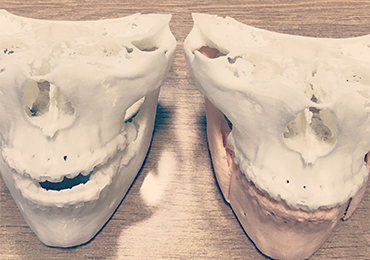Corrective Jaw Surgery
Corrective Jaw surgery or Orthognathic surgery is a part of Plastic and Maxillofacial surgery where the bones of the upper or lower jaw or both are moved to either realign the position of teeth or improve the appearance of the face.
Dr Vybhav Deraje teams up with Orthodontists, Speech therapists and Virtual surgical planning software companies to provide this service to patients requiring such surgery.
Reasons to undergo Corrective Jaw surgery
- To correct malocclusion of teeth – There are many types of malocclusion. It could be where the upper teeth are far ahead of lower teeth which is commonly referred to as ‘Overbite’. It could be where the lower teeth are far ahead of upper teeth which is commonly referred to as ‘Underbite’. There could be a gap between the upper and lower teeth which is commonly referred to as ‘Open bite’.
- To improve the appearance of face – Most commonly people seek corrective jaw surgery for facial deformities like ‘Flat face’ where the upper jaw is far behind the lower jaw, ‘Weak chin’ where the lower jaw is far behind the upper jaw, ‘Strong chin’ where the lower jaw is far ahead of the upper jaw causing a masculine appearance in a female patient etc.
- To improve the smile – People who have ‘Gummy smile’, ‘Excessive teeth show’ etc. also benefit from corrective jaw surgery.
- Cleft lip and palate deformities – People with cleft lip and palate usually have a ‘Dish face’ deformity and benefit tremendously from corrective jaw surgery.
- To improve snoring and sleep apnoea – People with snoring and sleep apnoea issues who have failed all previous medical and surgical management can potentially benefit from orthognathic surgery.
Approaches in Corrective Jaw surgery
- Orthodontics first approach – This will involve application of braces and orthodontic dental treatment for a period of 6 months to 1 year followed by surgery. Some amount of orthodontic treatment is sometimes required even after surgery.
- Surgery first approach – Here the jaw surgery is done first. It is then followed by orthodontic treatment for 6 months to 1 year.
Types of Corrective Jaw surgeries
Lefort I maxillary osteotomy
In this operation, cuts are made in the upper jaw (maxilla) and the bone is moved forwards, backwards, upwards or downwards depending upon the deformity and then fixed with titanium plates and screws in the new position.
Bilateral sagittal split osteotomy of mandible (BSSO)
In this operation, cuts are made in the lower jaw (mandible) and the bone is moved forwards, backwards, sideways or rotated upwards depending on the deformity and then fixed with titanium plates and screws in the new position.
Double jaw surgery
It is a combination of the above procedures which involves surgery on both maxilla and mandible.
Genioplasty
In this operation, cuts are made in the chin (central) region of the lower jaw and the bone moved forwards, backwards, upwards or downwards depending upon the deformity.
All surgeries involve cuts on the inside of the mouth, which leaves no external skin scars. These surgeries involve 3-4 days of hospital admission including 1 day of ICU stay. Patients may also need blood transfusions in some occasions.
Patient information sheet Download Now
-

Corrective Jaw Surgery
Testimonials
Look at what our patients have to say about their experiences with us.
Very comfortable to deal with. He clearly explains the condition and builds confidence. Also clarifies all your questions with patience. Highly recommended. Thank u sir.
Sandeep, CRANIOSYNOSTOSIS
Amazing doctor. Explained things thoroughly during treatment. Made my deep cut mark on cheek fully disappear, which I never thought would happen.
Anand, FACE INJURY
I was exceedingly comfortable during the surgery and Dr. Deraje is a wonderful surgeon. He also assisted me in getting a certificate promptly for my injury. My scars have healed perfectly too.
Anindya, WOUND MANAGEMENT
I met with an accident and surgery done for my finger tip. Vybhav did very well and I didn’t expect that my finger tip would survive. He has done very well and helpful person as well.
